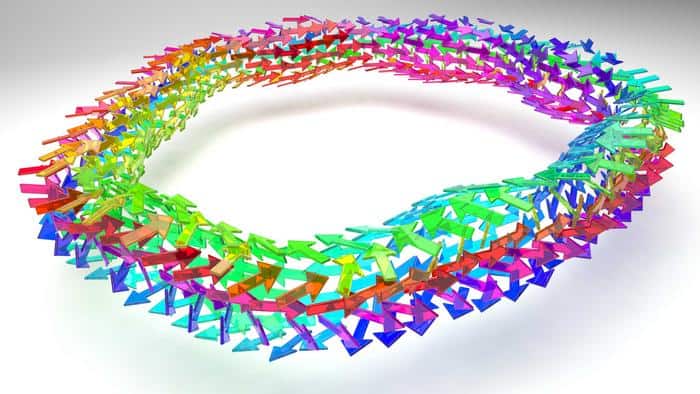
Researchers have observed three-dimensional magnetic spin structures called hopfions in a naturally-occurring material for the first time. The result could lead to new concepts for spintronics devices – that is, those that use the spin of an electron as well as its charge.
Hopfions are doughnut-shaped, three-dimensional versions of solitons, which are packets of waves that maintain their shape and size as they propagate through a material. Hopfions can also be thought of as closed, twisted strings of skyrmions, which are 2D solitons with a vortex-like structure.
Previously, hopfions had only been observed in synthetic multilayered materials. In the latest work, researchers led by Fengshan Zheng at South China University of Technology, Nikolai Kiselev of Forschungszentrum Jülich, Germany, and Filipp Rybakov at Uppsala University, Sweden, used transmission electron microscopy to observe them forming coupled states with strings of skyrmions in plates cut from a single crystal of iron germanide (FeGe).
Skyrmion strings and hopfion rings
“The spin configurations we discovered are perhaps the most complex topological magnetic textures ever imaged in magnetic crystals,” Kiselev says. “They are composed of two base elements linked to each other: the skyrmion strings and the hopfion rings around them.”
The discovery, as often happens in experimental physics, was unexpected. The researchers’ initial goal was to study skyrmions that have an arbitrary topological charge, which are known in the literature as skyrmion bags. They chose FeGe because they have been working on it since 2015 and had already discovered many interesting magnetic structures in it, including chiral bobbers, skyrmion braids and skyrmion-antiskyrmion pairs.
“We expected to observe skyrmion bags, but as well as seeing these, we also observed another structure, which puzzled us,” Rybakov says. “After that, there were several months of tough work, when we had to reproduce and accumulate experimental data and perform a long series of micromagnetic simulations to reconstruct each of the images we had recorded in the microscope.”
Edge phenomenon
One of the complicating factors, Rybakov adds, is that spin configurations in hopfions correspond to metastable states. This is different from skyrmions, which have spin configurations that are completely stable, making them relatively easy to observe.
A further complication is that hopfions do not arise spontaneously, so the researchers had to tease them out. They did this by exciting their crystal, which contains billions of magnetic atoms, in such a way that the magnetic moments of atoms in a tiny volume of the crystal took on what Rybakov terms a “topologically non-trivial” magnetic texture. “This is a texture that, by continuous transformations, cannot undergo a transition into a ferromagnetic state in which all the spins point in nearly the same direction,” he explains. “Continuous transformations keep the angle between the neighbouring spins small, meaning much smaller than 90 degrees.”
A similar process occurs for topological solitons in bulk crystals, he notes. These 2D spin structures cannot arise except in the presence of a discontinuity where the angles between spins becomes very large. However, states with discontinuities are energetically unfavourable, and under normal conditions they do not form. Only at the edges of the sample, where the magnetization field naturally exhibits discontinuities, can these structures appear.
Probabilistic character
When the researchers placed their plates of FeGe in a cycling magnetic field that sequentially changed direction, they noticed “an interesting phenomenon” at the sample’s edges, Zheng tells Physics World. “In particular, the [magnetic] spin texture forms closed loops of spiral modulations,” he says. “As more cycles of the field are applied, more concentric loops are formed.”
After much painstaking effort, the researchers found that configurations with many such concentric loops represent a state with a high probability of transforming into a hopfion ring as the magnetic field gradually increases. In most cases, however, the system would converge to states with a lower energy than the hopfion ring.

Tailored material makes speedier skyrmions
“Because of this, the appearance of the hopfion has a probabilistic character,” Kiselev explains. “This made the experiment particularly challenging, but we found that the probability of hopfion appearing increases at a specific temperature range. While it is yet difficult to quantify the probability of the quasiparticles appearing, automating our experiment might help us do that in the future.”
Closed loops of spiral modulations
Though it is hard to predict applications for hopfions, Kiselev notes that unlike skyrmions, they are three-dimensional objects that can move in three spatial dimensions. They might therefore find use in 3D versions of already-established skyrmion concepts, such as racetrack memories, neuromorphic computing and quantum bits.
The researchers, who report their work in Nature, now plan to study how an applied current affects the motion of hopfion rings. They also aim to observe other hopfions, including those that are not linked to skyrmion strings. “We hope to perform a tomography experiment too,” Zheng says. “This would provide us with a real three-dimensional structure of hopfion rings, instead of the just the two-dimensional projected images we have today.”
